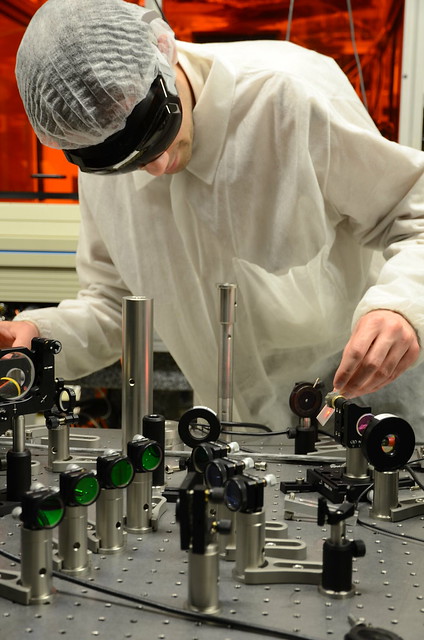High Intensity Lasers
Generation of high peak power, high repetition rate laser pulses
The objective of this project is the full development of an optical parametric chirped pulse amplification (OPCPA) system, able to provide high energy (~ 10’s of mJ), ultrashort (~10 fs), and high repetition rate (tens of Hz) laser pulses in a noncollinear geometry. The OPCPA will be pumped by diode-pumped solid state lasers (DPSSL) using ytterbium-doped amplifying materials. The high repetition rate and efficiency of these Yb-based amplifiers makes them ideal for supplying the pump for an OPCPA stage.
The system will consist in a laser chain with three differentiated sub-systems, each being developed by members of the laser team:
- signal generation by supercontinuum generation in bulk media using femtosecond pulses, obtaining ultrabroadband spectra from 400 to 1100 nm;
- pump generation, consisting in a two-stage diode-pumped ytterbium-based amplifier, capable of generating pulses in the 100 mJ range, at 1030 nm (or 515 nm after frequency doubling), and high-repetition rate (>1 Hz);
- OPCPA using broadband geometries, and testing broadband nonlinear materials such as yttrium calcium oxyborate (YCOB).
- The laser team as a whole is working towards this common goal, sharing the tasks and working in close collaboration
The OPCPA laser is designed to operate in the range 650-950 nm, pumped at 515 nm, so it requires a carefully controlled dispersion over 300 nm, in order to provide compressed pulses in the 10’s of fs range.
Schematic of diode-pumped OPCPA system.
Generation and characterization of white-light continuum in bulk media
The propagation of intense, short laser pulses through a transparent optical medium can modify their temporal, spatial and spectral properties leading to interesting nonlinear interactions. A well-known phenomenon, termed white-light continuum (WLC) or supercontinuum generation, consists in ultrabroadening of the original spectrum, extending from the ultraviolet to the infrared .
Continuum generation in bulk media involves complex coupling phenomena between spatial and temporal effects, posing considerable challenges to an understanding of the role of the several mechanisms involved. This requires a detailed experimental study of the continuum characteristics for a given set of parameters, which in turn is also challenging due to the extremely broadband nature and the large (~1000) time-bandwidth product of the pulses.
We are interested in the possibility of using WLC generated in bulk media as an ultrabroadband source for seeding optical parametric amplifiers. Our research is focused on testing and optimizing the conditions for creating broadband, stable pulses, pumped at wavelengths beyond 1 µm. We intend to implement a WLC stage as the seed for a 10 mJ, 10 fs OPCPA system pumped by an optically synchronized Yb-based amplifier.
We have performed a comprehensive evaluation of continuum generation in sapphire pumped by 280 fs, mJ-level, 1053 nm, 10 Hz pulses with powers well above (300X) the critical power, in terms of spectral broadening, efficiency and stability. We have used a multi-shot XFROG technique with angle-dithering for characterizing the spectral phase of the continuum generated, in order to obtain full intensity and phase information. Currently we are working on the compression of these pulses at the mJlevel using chirped mirrors.
Retrieved temporal and spectral intensity and phase from the XFROG trace.
References
T. Imran, G. Figueira, “Intensity–phase characterization of white-light continuum generated in sapphire by 280 fs laser pulses at 1053 nm, Journal of Optics 14, 035201 (2012)
Ultrabroadband optical parametric amplification
Optical parametric chirped pulse amplification (OPCPA) is an alternative technique for high power amplification, where a birefringent nonlinear crystal mediates an energy transfer from an energetic pulse (pump) to a low intensity, chirped laser pulse (signal), creating a third beam (idler). Many problems that afflict common amplifiers are virtually absent in OPCPA, making it the technique of choice for both large-scale projects at the PW and smaller scale laser systems.
The main advantages of OPCPA include a high single pass gain (up to 105), no thermal deposition, no ASE, extremely high amplification bandwidth that allows for ~fs pulses, and scalability. On the other hand, it requires a high intensity pump, high precision pump-seed synchronization to reach good efficiencies, and appearance of parametric fluorescence,although limited to the pump-defined time window.
We are interested in evaluating suitable nonlinear crystals for high peak power, high repetition rate OPA, that may lead to the next generation of PW systems at Hz rates. In particular, our current research focuses on evaluating ultrabroadband amplification in the biaxial crystal yttrium calcium oxyborate (YCOB), which shows an excellent compromise between high average and high peak power pulse generation. Our goal is to develop a system capable of generating ~10’s mJ, ~10 fs pulses in the near infrared (800 nm) based on this concept. For this, we have been using a dedicated simulation code for studying the amplification of realistic ultrabroadband (hundreds of nm) pulses.
| BBO | LBO | KDP | DKDP | YCOB | |
|---|---|---|---|---|---|
| d(eff) (pm/V) | 2.01 | 0.83 | 0.26 | 0.22 | 1.4 |
| Aperture (cm) | 2 | 2 | 40 | 40 | 8 X 20 |
| Energy limit (J) | 3 | 3 | >1000 | >1000 | 120 |
| P(av) (kW) | 4.6 | 1.5 | 0.007 | 0.3 | 13 |
Comparison of relevant laser characteristics of selected nonlinear crystals for OPCPA. (d(eff) – effective nonlinearity, P(av) – average power limit) [Liao et al., Opt. Lett. 31, 1277 (2006)]
Diode-pumped ytterbium-doped amplification
Diode pumped laser amplifiers based on ytterbium-doped solid-state media are capable of producing short laser pulses with high energy at high efficiencies. For these reasons, they are widely regarded as a key technology for future scientific high peak power light sources, allowing laser systems with much higher repetition rate than state of the art installations.
We are interested in the development and application of a medium-energy (~100 mJ) Yb-based two-stage amplifier for pumping an ultrashort pulse OPCPA laser at Hz repetition rates. This will require assembling a regenerative and a multipass amplifier based on Yb:glass and Yb:CaF2 respectively.We have developed realistic simulation codes for amplification in several Yd-doped hosts, while simultaneously performing experimental test.
Simultaneously we have been collaborating with FSU Jena in the testing and development of advanced amplifier configurations. This has led to the recent commissioning of a new OPA-based front end for the PHELIX laser at GSI Garching.
Recent achievements include:
- – successful operation of a multipass amplifier with an output energy of up to 50 mJ at 1 Hz repetition rate
- – design of the new full dual stage amplifier and the frequency doubling optics.
- – collaboration in the development of the first 10 mJ-level Yb:KYW diode-pumped regenerative amplifier at 1040 nm, which amplifies picosecond pulses at repetition rate of 10 Hz (front-end of the PHELIX petawatt laser as the pump for the short pulse OPA system)
Partial view of 100 mJ level multipass amplifier.
References
J. Wemans, C. João, G. Figueira, “Evaluation of hybrid ytterbium-neodymium laser amplification at 1053 nm”, Appl. Phys. B – Lasers and Optics 101, 1-2, 103 (2010).
C. P. João, J. Körner, M. Kahle, H. Liebetrau, R. Seifert, M. Lenski, S. Pastrik, J. Hein, T. Gottschall, J. Limpert and V. Bagnoud “Development of a 10 mJ-level optically synchronized picosecond Yb:KYW amplifier at 1040 nm for OPCPA pumping”, Diode-Pumped High Energy and High Power Lasers, SPIE Optics + Optoelectronics Proceeding of SPIE 8080, 808008 (2011)









